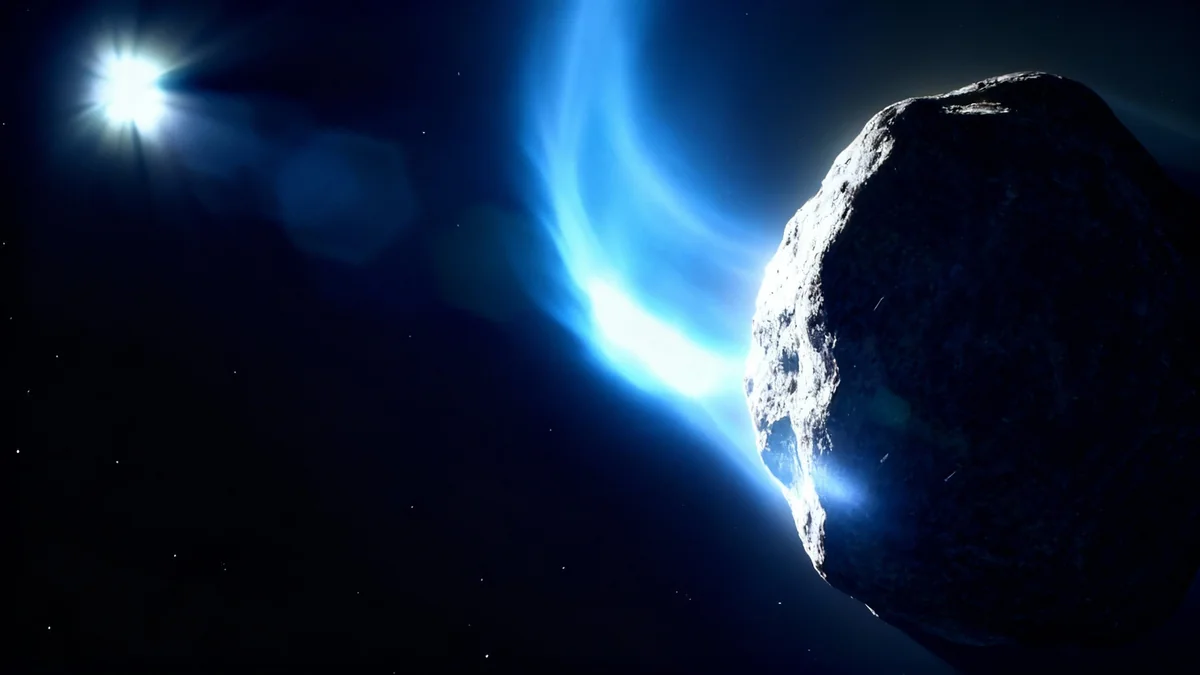Scientists have identified a dark object located 10 billion light-years away that could be the smallest clump of pure dark matter ever observed. The object, which has a mass one million times that of our sun and contains no stars, was detected by the gravitational distortion it creates in the light from a more distant galaxy.
This discovery provides strong evidence for the cold dark matter theory, a leading model that explains how galaxies form. The finding was made during observations of a cosmic phenomenon known as an Einstein ring, where the gravity of a massive foreground galaxy bends light from a background source into a circular shape.
Key Takeaways
- A dark object with a mass one million times that of the sun has been detected 10 billion light-years away.
- The object appears to contain no stars, suggesting it could be a pure clump of dark matter.
- It was discovered as a small distortion in a gravitationally lensed image of a background galaxy, known as an Einstein ring.
- The finding supports the cold dark matter theory, which is fundamental to our understanding of cosmic structure formation.
- If confirmed, this would be the smallest standalone dark matter clump ever found by a factor of 100.
A Discovery Through Gravitational Lensing
The research team, led by astronomers from the University of Groningen and the Max Planck Institute for Astrophysics, was not initially searching for dark matter. Their primary goal was to study a distant object known as a compact symmetric object (CSO), which is a young, active supermassive black hole producing small jets of radio emissions.
To get a detailed view, they used a technique called gravitational lensing. This occurs when a massive object, like a galaxy, sits between Earth and a more distant object. The foreground galaxy's gravity bends spacetime, acting like a cosmic magnifying glass that warps the light from the background source into an arc or a complete circle called an Einstein ring.
What is an Einstein Ring?
An Einstein ring is a specific and spectacular form of gravitational lensing. It happens when an observer, a lensing object (like a galaxy), and a background light source are almost perfectly aligned. The gravity of the lensing object bends the light from the source into a nearly perfect ring shape, as seen from the observer's perspective.
Global Telescope Network Provides Unprecedented Detail
To achieve the necessary resolution for their study, the scientists combined data from a worldwide network of radio telescopes. This included the European Very Long Baseline Interferometric Network, the Green Bank Telescope in the U.S., and the Very Long Baseline Array in Hawaii.
By linking these observatories, they created a virtual telescope with a baseline, or diameter, almost as large as the Earth itself. This immense scale allowed them to see extremely fine details in the distant universe. It was during this high-resolution observation that they noticed something unexpected.
Analyzing the Anomaly
While analyzing the data from the Einstein ring, the team discovered a subtle but distinct interruption, or "notch," in the otherwise smooth arc of light from the background CSO. This imperfection indicated that another, smaller object was present along the line of sight, adding its own gravitational influence to the light-bending effect.
Calculating the Object's Mass
By using supercomputer algorithms to create a "gravitational image" that maps the distribution of mass, researchers determined the properties of the unseen object. The size and shape of the distortion in the Einstein ring allowed them to calculate that the object must have a mass approximately one million times that of our sun.
The team considered two main possibilities for this mysterious object. One is that it could be a small, inactive dwarf galaxy that has run out of gas to form new stars and is therefore too faint to see directly. The other, more compelling explanation is that it is a dense, isolated clump of dark matter.
"Hunting for dark objects that do not seem to emit any light is clearly challenging," said Devon Powell of the Max Planck Institute for Astrophysics in Germany in a statement about the research.
Supporting the Cold Dark Matter Theory
This discovery has significant implications for our understanding of the universe. Dark matter is a mysterious substance that does not emit or reflect light, but its gravitational effects are visible everywhere. It is believed to make up about 85% of the matter in the cosmos and acts as the scaffolding upon which galaxies are built.
The leading model for this substance is called the cold dark matter theory. This theory proposes that dark matter is made of slow-moving, low-energy particles that can easily clump together under their own gravity to form structures of various sizes, from tiny halos to the massive halos surrounding large galaxies.
- Cold Dark Matter: Composed of slow-moving particles that can form small, dense clumps. This is the dominant theory.
- Hot Dark Matter: Composed of fast-moving, high-energy particles (like neutrinos) that would struggle to clump together, resulting in much larger, more diffuse structures.
Finding a small, dense, and isolated clump like this one provides strong observational support for the cold dark matter model. If dark matter were "hot," such a small concentration would not be able to form.
Future of Dark Matter Research
One of the key questions in cosmology is determining the smallest possible size for a clump of dark matter. The properties of the smallest clumps can place important constraints on the nature of dark matter particles themselves. Finding this object, which is 100 times smaller than any similar object previously found alone, is a major step forward.
"Finding low-mass objects such as this one is critical for learning about the nature of dark matter," stated team member Chris Fassnacht of the University of California, Davis. The discovery aligns with predictions from the cold dark matter theory.
The team's findings are detailed in two separate scientific papers. One, focusing on the dark object, was published in the journal Nature Astronomy. The other, detailing the observations of the compact symmetric object, appeared in the Monthly Notices of the Royal Astronomical Society.
"Given the sensitivity of our data, we were expecting to find at least one dark object, so our discovery is consistent with the so-called cold dark matter theory," Powell explained. "Having found one, the question now is whether we can find more and whether the numbers will agree with the models."
The success of this method opens a new window for finding similar dark matter concentrations. By searching for more of these gravitational anomalies in other lensed systems, astronomers hope to build a census of low-mass dark matter clumps and refine our understanding of this invisible component of the universe.





